All?gre Claude J. Isotope Geology
Подождите немного. Документ загружается.


caps. For benthic species, th e dominant factor is the isotopic £uctuation of the ocean as
Shackl eton (1967b) had surmised. In addition, Duple ssy’s group and Shackleton estab-
lished that an additional isotope fractionation occurred which was characteristic of each
spe cies of foraminifera studied. But those ‘‘ vital e¡ects’’ were calibrated and so isotopic
measurementson di¡erentspecies could be made consistentw ith each other.
Exercise
We have just seen that the d
18
O variation of foraminifera was mostly due to d
16
O variation
because of melting ice. Let us look more closely at the quantitative influence of melting polar
ice on d
18
O. Imagine an intense glacial period when the sea level falls by 120 m. What would
be the volume of polar ice and the d
18
O value of sea water?
Answer
The ocean surface area is 3.61 10
8
km
2
. The volume of the ocean is 1370 10
6
km
3
. The
volume of present-day polar ice is 29 10
6
km
3
. If the sea level is 120 m lower, 46 10
6
km
3
has been stored in the ice caps, corresponding to a mass fraction of the hydrosphere of 3.3%.
The polar ice caps were 1.6–2 times larger than today.
If we take the d
18
O value of ice as 50ø, then 50ø 0.033 ¼1.65ø. There is indeed a
difference in d
18
O of this order of magnitude between glacial and interglacial periods. Notice
that, as with radiogenic isotopes, these effects could not be detected if we did not have a very
precise method for measuring d
18
O.
Glaciers
Another interesting application of this fractionation wasbegun on glaciers independently
by Sa m uel Eps tei n ofthe California Institute of Technology and (more systematically and
continuously) byWil li Dan sgaard of Copenhagen University.When a core ofpolar glacier
ice is taken, it has layers ofstrati¢ed ice which can be dated by patient stratigraphy and var-
ious radiochronological methods. Now, the study of these ice strata reveals variations in
d
18
OanddD (Dansgaard, 196 4; Epstein et al., 1965; Dansgaard and Tanber, 1969)
(Figures7.29 and7.3 0).
For a single region such variations are analogous and mean the sequence of one glacier
can be matched with the sequence of a neighboring glacier. An isotope stratigraphy of
glaciers c an be de¢ned. We can venture an interpretation of these facts in two ways.
Either we accept that the origin of precipitation has varied over recent geological time
and we then have a way of determining variations in the meteorological cycle of the past.
Or we consider that the fractionation factor has varied and therefore the temperature has
varied.
Research by Dansgaard and his team on the ice ¢rst of Greenland and then of
Antarctica showed that th e te mpe rat ure e¡e c t i s predo mina nt. By simultaneously
measuring isotope composition and temperature, he showed that the d
18
OanddD
correlation did indeed correspond to this e¡ect. Moreover, the qualitative rule is the
reverse of the carbonate rule: when the temperature rises, both d
18
OanddD increase,
because fractionation diminishes with temperature; but the d values are negative and so
move clos er tozero(Figure 7.31). A simple empiricalruleisthatwhenever thetemperature
rises by18C, d
18
O increasesby 0.7ø.
409 Paleoclimatology
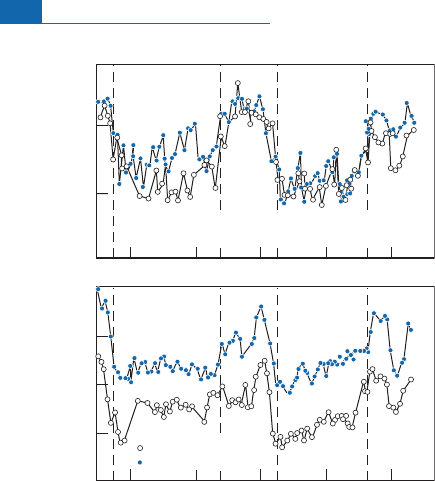
We can investigate why d
18
O
H
2
O
£uctuation is very important for foramin ifera and why it is
the local temperature e¡ect that dominates with ice. Because isotope fractionation at very
low temperatures becomes very large and dominates isotope £u ctuation related to the
water cycle. But we shall see thatthis assertion mustbequali¢ed. Modern studiesof isotope
£uctuations of glaciers use a co mbination of both e¡ects, loc al temperatures and isotopic
changes in thewater cycle, as for foraminifera,butwith di¡erentrelativeweightings.
7.7.2 Systematic isotope paleoclimatology of the Quaternary
Wehavejustseentherearetwowaysofrecording pastte mperatures.
(1) Oneisbasedon
18
Oanalysisoffoss ilshellsinsedimentaryseries (marineand continen-
tal cores).
(2) Theother uses
18
Oanalysis ofaccu mulated layers of icein theice caps.
Both th ese methods have progressively converged to allow very precise studies of cli matic
£uctuations in the Quaternary and more especially for the last million years. Nick
Shack leto n andWilli Dansgaard sharedthe CrafoordPrizeinrecognitionoftheircomple-
mentaryachievement. Each method has its limits, and itis onlygradually that wehavebeen
able to compareand usebothtypesofrecords in a complementary way to decipher climatic
variations thathavea¡ectedour planetoverthe last mi llionyears andwhich consistin alter-
nati ng glacial andwarmer inte rglacial periods.
δ
18
O(‰)
Depth (m)
2
1
3 5
GlacialGlacial
7 9
3
4
δ
13
C(‰)
0
1
3 5 7 9
-1
Inter-
glacial
Inter-
glacial
Cibicides sp.
Neogloboquadnina. pachyderma
Figure 7.29 Comparison of d
13
C and d
18
O fluctuations in a pelagic (blue circles) and a benthic (white
circles) species of foraminifer from the Antarctic Ocean. The d
13
C variation (above) is represented to
show there is a shift for d
18
O (below) but not for d
13
C.
410 Stable isotope geochemistry
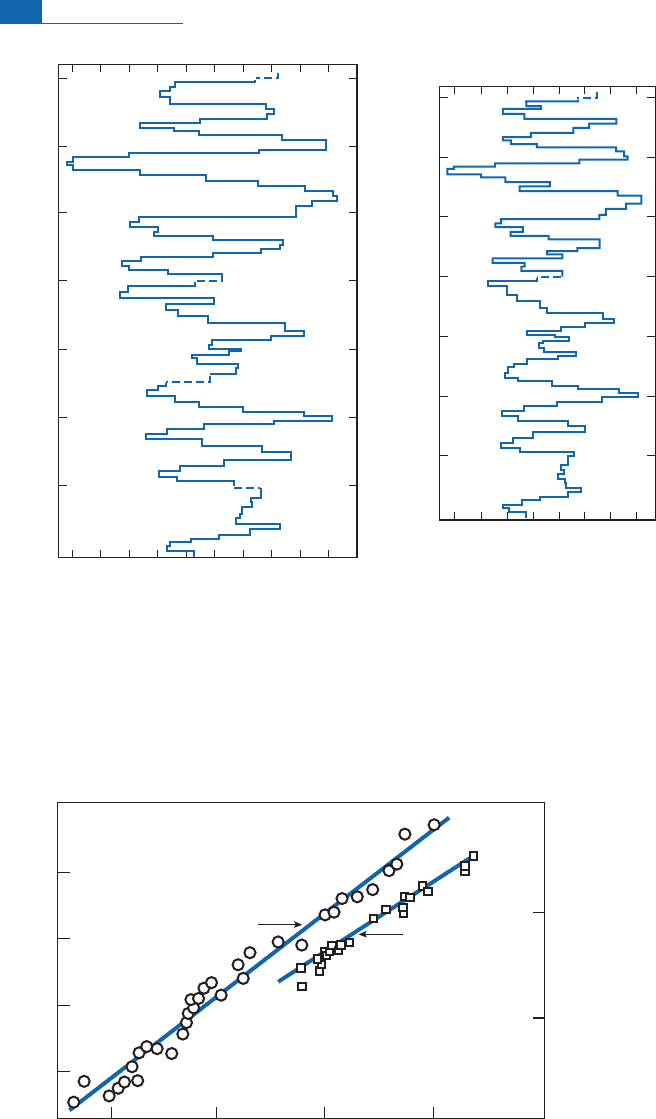
2100
2000
1900
1800
1700
1600
1500
–32 –31 –30 –29 –28 –27 –26 –25 –24 –23
Depth (cm)
δO
18
‰
2100
2000
1900
1800
1700
1600
1500
–25 –24 –23 –22 –21 –20 –19 –18
Depth (cm)
δD%
S
S
S
S
S
S
S
S
S
S
S
S
S
S
(S?)
(S?)
S
S
S
S
S
S
S
S
(S?)
(S?)
(S?)
Figure 7.30 Variations in d
18
O and dD with depth in an Antarctic glacier. Summers (S) can be
distinguished from winters. (Caution! dD is in percent!) After Epstein and Sharp (1967).
–200
–30
–20
–40
–150
–250
–300
–350
–50 –40 –30
Temperature (°C)
δD (‰)
δ
18
O (‰)
–20 –10
Antarctic
(Terre Adélie)
Greenland
Figure 7.31 Relationship between temperature,
18
O, and D in snowfall at the poles. After Lorius and
Merlivat (1977) and Johnsen
et
a
l
.(1989).
411 Paleoclimatology

Core sampling (sequential rec ords)
Cores of marine sediments canbe taken from all latitudes and longitudes (in the ocean and
from continentsand lakes); however, two conditions restricttheir use. First, sedimentation
must have occurred abovethe‘‘carbonate compensation depth’’ for there tob e any measur-
able fossil tests left. And second, sedimentation must have been very rapid to provide a
recordwithgoodtime resolution. Sedimentary coreshaveno time limits other thanthe life-
span of the ocean £oor. Quaternary, Tertiary, and Secondary cores can be studied up to
120 Ma, which is the age of the oldest remnants of oceanic crust that have not been swal-
lowe d up bysubduction (ancientcores are c ompacted andtransformed intohard rocks and
sotime resolution is not asgood).
For ice caps,the¢rstproblem is,ofcourse, theirlimitedgeographicalandtemporal extent.
Geographically, records are primarily from the glaciers of Antarctica and Greenland.
Mountainglaciershavealso recordedclimatic eventsbutovermuchshortertime-spans.
13
Ice caps are limited in time. For a long time, the longest core was one from Vostok
in Antarctica covering 420 000 years. A new c ore of EPICA has been drilled and covers
700 000 years. Cores from the big mountain glaciers go back a mere 2000 years or so. For
b oth types of record ^ se diments and ice ^ precise, absolute dating is essential, but here
again many di⁄culties arise. Especially because as research advances and as studies
becomeever more re¢nedforeversmallertime-spans,theneedfor precision increases con-
stantly.There is scope for
14
C dating and radioactive disequilibrium methods on sedimen-
tary cores, buttheir precision leaves something tobe desired. Useful cross-checki ng canbe
done with paleomagnetism and well-calibrated paleontological methods. In turn, the oxy-
gen isotopes ofawell-dated core canbeused todatethelevelsofothercores. Thus,gradually,
a more orless reliable chronologyis established, which mustbe constantly improve d. Dating
is di⁄culton ice caps exceptfor the mostrecentperiodswhereannual layers canbe counted.
Methods based on radioactive isotopes such as
14
C,
10
Be,
36
Cl,
87
Kr, and
37
Ar are used, but
theyare extremelydi⁄culttoimplementboth analytically (ice is averypure material!)andin
terms ofreliability. Switzerland’s Hans Oeschger (and his team) is associatedwith the devel-
opment of these intricate techniques for dating ice, which, despite their limitations, have
broughtaboutdecisiveadvancesin decipheringtheicerecord (Oeschger,1982).
These clari¢cations should make it understan dable that establishing ti me sequences of
recordsis a di⁄cultand lengthy jobthatis constantlybeing improved.A ll reasoning should
make allowancefor this.
Deciphering sedimentaryseries and the triumph of Milankovitch’s theory
Between 1920 and 1930, the Yugoslav mathematician and astronomer Milutin
Milankovitch developed a theory to account for the ice ages that had already been identi-
¢ed by Quaternary geologists (see Milankovitch, 1941). These periods were thought to
be colder.The polar ic e extended far to the south and mountain glacie rs were more exten-
sive too (Figure 7.32). Alpine glaciers stretched down as far as Lyon in France. These
glacial traces can be identi¢ed from striated rock blocks forming what are know n as
moraines.
13
They have been used by Lony Thompson of Ohio State University for careful study of recent tempera-
ture fluctuations (see his 1991 review paper).
412 Stable isotope geochemistry
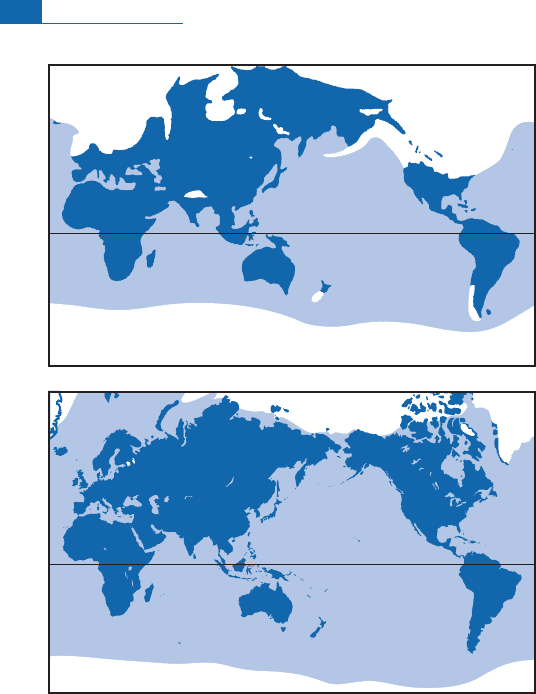
Mil ankovitch’s theory gave rise to vehement controversy (as vehement as that over
We g e n e r ’s theoryofcontinentaldrift
14
). And yetthisvision ofthe pioneers ofthe1920s was
largelyaccurate.This isnottheplacetosetoutthistheoryin full.Itcanbefoundintextbooks
on paleoclimatology, forexample, Bradley(1999). However, we shal l outlinethe mainprin-
ciples and theterms toclarify what wehaveto sayaboutit.
The Earth’s axisofrotation isn otperpendicular toitsplaneofrotation aroundthe Sun. It
deviates from it by 238 on average. But the axis of this deviation rotates around the vertical
over a period of 23 000 years. A further movement is superimposed on th ese, which is the
£uctuation of the angle of deviation between 21.88 and 24. 48.The period of this £uctuation
is 41 000 years.The ¢rst of these phenomena is termed preces sion,thesecondisobl iqu it y.
A third phenomenon is the variation in the ell ipiticity of the Earth’s orbit,withaperiod
of 95 000 years. These three phenomena arise from the in £uence on th e Earth of the
Sun, Jupiter, and the other planets and the tides. They not only combine but are
Today
18 000 years ago
Figure 7.32 Worldwide distribution of ice in glacial and interglacial times.
14
Wegener had been the first, with his father-in-law Ko
¨
ppen, to suggest an astronomical explanation for
the ice ages before becoming an ardent defender of Milankovitch.
413 Paleoclimatology
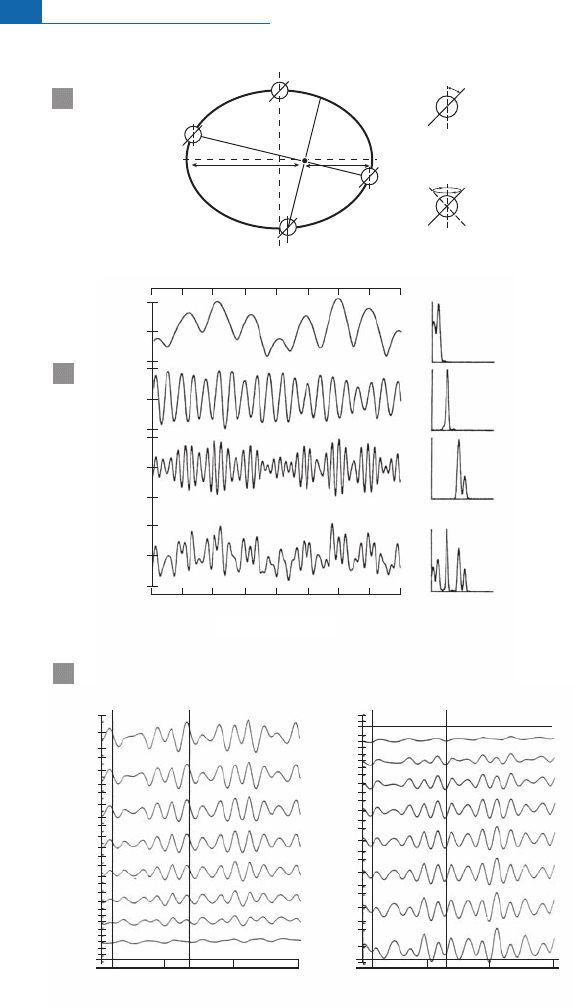
a
b
c
0.05
400
Total
Precession
Obliquity
Excentricity
200
413
100
41
23
19
0
600 800
0.02
0.0
24.5
23.3
22.0
-0.07
-0.02
0.04
2.7
0.0
2.7
Time (ka BP)
Fourier spectrum
Summer
solstice
Winter
solstice
Autumn
equinox
Winter
equinox
Sun
Perihelion
Precession
Obliquity
Aphelion
d
p
d
a
Age (ka)
III
Insolation in June
1230
950
80°N
60°N
40°N
20°N
0°N
20°N
40°N
60°N
80°N
1130
900
1140
930
880
740
870
520
360
280
100
100
0
0
1080
910
1000 200 300
Age (ka)
III
Insolation in December
100
0
100
0
80°N
60°N
40°N
20°N
0°N
20°N
40°N
60°N
80°N
1000 200 300
370
270
670
520
810
740
1080
880
1150
930
1150
910
1260
980
Figure 7.33 The principle of Milankovitch’s theory. (a) The three parameters that change: eccentricity of
the orbit, obliquity, and precession. (b) Variations in the three parameters calculated by astronomical
methods with their Fourier spectrum on the right. (c) Variation in the sunlight curves in June and
December with latitude, calculated by the theory.
414 Stable isotope geochemistry

superimposed, leading to complexphenomena.Thus, at present, the Earth is closestto the
Sun on 21 December, but the Earth’s axis is aligned away from the Sun, and so, in all, the
northern hemisphere receives little sunlight. It is winter there, but other conjunctions
also occur. Thus we can calculate the sunshine received during the year at various lati-
tudes. Cel estial mechanics mean such calculations can be made precisely (see Figure 7.33
for a simpli¢ed summary). As Milankovitch understood, if little sunshine reaches the
Earth at high latitudes in summer the winter ice will remain, the white surface will re£ect
solarradiation, andth e coolinge¡ectwillbeampli¢ed.This isagoodstar ting pointforcli-
matic cooli ng.
What should be remembered is that when we break down the complex signal of sunlight
received by the Earth using Fourier analysis methods (that is, when we identify the si ne-
wave frequencies that are super imposed to make up the signal) we ¢nd peaks at 21 000,
41000,and 95 000years.Whenwe conduct a similarFourierdecompositionfor d
18
Ovalues
recorded by foraminifera in sedimentary series, we ¢nd the same three frequencies
(Figure7.34 ).
The d
18
O variations re£ect those of the Earth’s temperatures. This ¢n ding con¢rm s
Mil ankovitch’s theory (at least as a ¢rst approximation) and so fully bears out the early
studies of Emiliani. In complete agreement with the theory, th e sedimentary series also
showed that climatic variations were very marked at the poles (several tens of degrees),
very low in the intertropical zone, and intermedi ate in the temperate zones (of the order
of 5 8C) .
Figures7.35 and 7.36 giveafairlycompletesummaryofthe essentialisotopicobservation s
made fromsedimentarycores.
The sedimentarycorerecord(Figure7.35)also shows in detail how thetemperaturevar-
iations evolved. Cooling i s slow, followed by sudden warming. Finer £uctuations are
superimposed on these trends but their frequencies match those of the Milankovitch
cycles.
Con¢rmation of Milankovitch cycles byAntarctic isotope records
Itwassome considerabletimebeforeMilankovitchcycleswere con¢rmedintheicerecords,
for two reasons.There were no ice cores long enough and so covering a long enough time-
span andthe dating methodsweretooimprecise.
It was only after the famous Vostok core from Antarctica was studied by the Franco-
Russ ianteam thatevi dence of Milankovitch cycles was foundin the ice record.Butthe core
yielded much morethanthat: it allowed climaticvariations tobe correlated withvariations
ofother parameters:
dustcontent: itwas realizedthat during ice ages therewas much more dust andth erefore
morewindthanduring interglacialperiods.
greenhouse gas (C O
2
and CH
4
) content in air bubbles trapped inthe ice ^ when the tem-
peratureincreases there is an increase in CO
2
(inthe absence ofhumanactivity!).
This last question on the debate about the in£uence of human activity on the greenhouse
e¡ect and so on climate is a fundamental one.Which in creased ¢rst, temperature or CO
2
levels? It is a di⁄cult problem to solve because temperature is measured by dDinice
415 Paleoclimatology
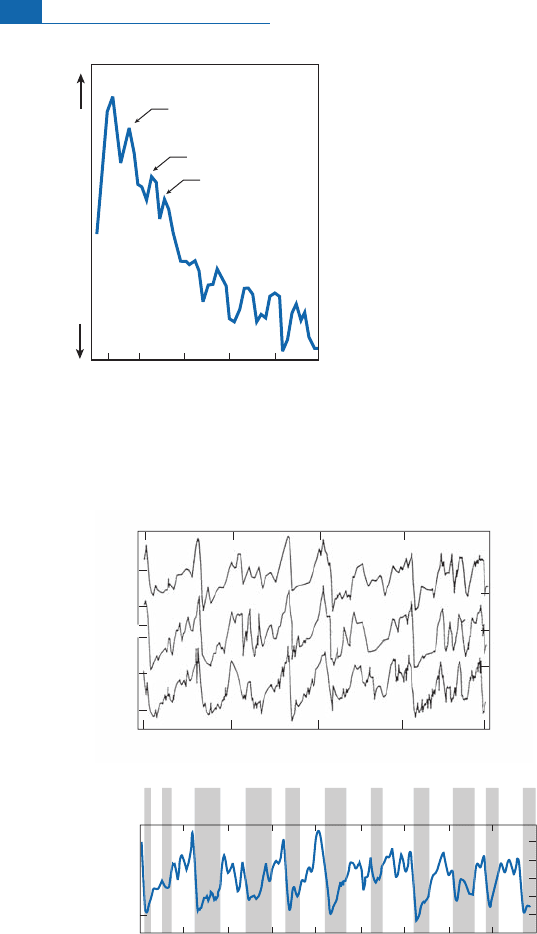
100 30 15 10 7.5 6
Amplitude of climatic cycle
highlow
Cycle duration (ka)
43
24
19
Figure 7.34 Fourier spectrum of paleotemperatures using oxygen isotopes.
3.0
5.0
4.0
3.0
4.0
5.0
0
0.0
0.2 0.4 0.6 0.8
200
2 6 8 10 12
14
16
18 20
400 600 800
3.0
4.0
5.0
δ
18
O(‰) δ
18
O(‰)
δ
18
O(‰)
δ
18
O(‰)
Isotopic stages
2
1
0
-1
-2
2
200 0 400 600 800
Age (ka)
4 6 8
10 12 14 16 18 20 22
Site 677
Site 552
Site 607
Figure 7.35 Records of d
18
O in foraminifera and the synthetic reference curve. (a) Record of d
18
O for
benthic foraminifera at three sites: site 552 – 568 N, 238 W in the North Atlantic; site 607 – 418 N, 338 W
in the mid Atlantic; site 667 – 18 N, 848 W in the equatorial Pacific. Correlation between the three cores
is excellent. (b) Synthetic reference curve produced by tuning, which consists in defining the timescale
so that the Fourier decomposition frequencies of the d
18
O values of the cores match the astronomical
frequencies from Milankovitch’s theory. The period is then subdivided into isotopic stages. The odd
stages are warm periods and the even stages (shaded) glacial periods. (Notice that the interglacials
correspond to increased d
18
O values and fluctuations are just a few per mill.) After various compilations
from Bradley (1999).
416 Stable isotope geochemistry
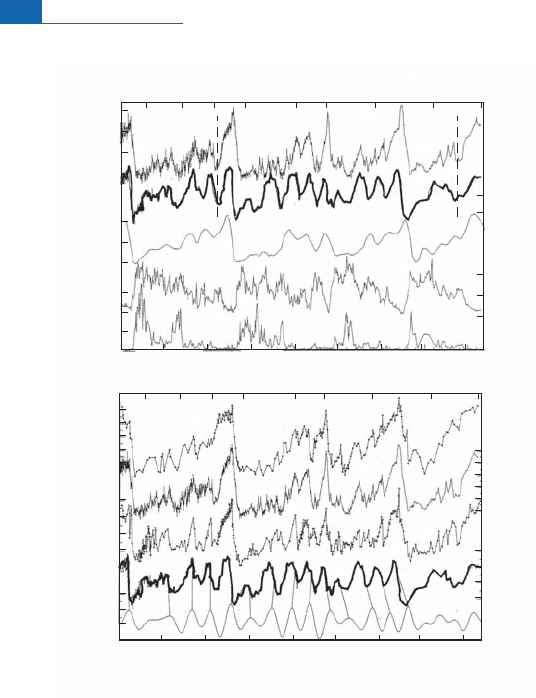
whereas CO
2
is measured from its inclusion in ice. Now, gaseous inclusions are formed
by the co mpacting of ice and continue to equilibrate with the atmosphere, that is, the air
samplesareyounger thanthe icethatentrapsthem (Figure 7.37).
We need, then, to be able to measure the temperature of inclusions directly and com-
pare it with the temperat ure measured fr om the D value of the ic e. A method has been
developedbySeveringhausetal.(2003)formeasuringthetemperatureof£uidinclusions
using
40
Ar/
36
Ar and
15
N/
14
N isotope fractionation. After stringent calibration, the teams
at the Institut Simon-Laplace at Versailles University and at the Scripps Institution of
Oceanography (La Jolla, California) managed to show that the increase in CO
2
lags
behind the in crease in temperature by 800 years (Figure 7.38) and not the other way
round as asserted by the traditional greenhouse-e¡ect model (Severinghaus et al., 199 9;
Caillonetal.,2003).Now,weknowthatCO
2
solubility in sea water declines as tempera-
ture rises and that the characteristic time for renewal of the ocean water is 1000 years.
The ¢rst phase of temperature i ncrease followed by the increase in CO
2
,withalagof
800 years, can be readily understood, then, if we invoke the lag because of the thermal
inertia of the ocean.There may also be some feedbackof the CO
2
e¡ect on temperature.
Insolation (J)
65
°
N
CH
4
(ppbv)
CO
2
(ppbv)
δ
18
O atm (‰)
Temperature
(°C)
Age (years BC)
280
a
a
b
c
d
e
b
c
d
e
100 000 200 000 300 000 400 000
240
700
600
500
400
100
50
0
200
2
0
–2
–4
–6
–6
–0.5
–0.0
0.5
1.0
Dust
Ice
volume
δD (‰)
Na (ppb)
δ
18
O atm (‰)
100 000 200 000 300 000 400 000
–420
–440
–460
–480
0.0
0.5
1.0
1.5
1.0
0.5
110 ka 390 ka
5.4
11.24
5.1
5.3
5.5
7.1
7.3
7.5
8.5
9.1
9.3
11.3
11.1
0
50
100
1.0
0.5
0.0
–0.5
Figure 7.36 Various parameters recorded in the Vostok ice core. After Jouzel
et
a
l
.(1987) and Petit
et
a
l
.
(1999).
417 Paleoclimatology
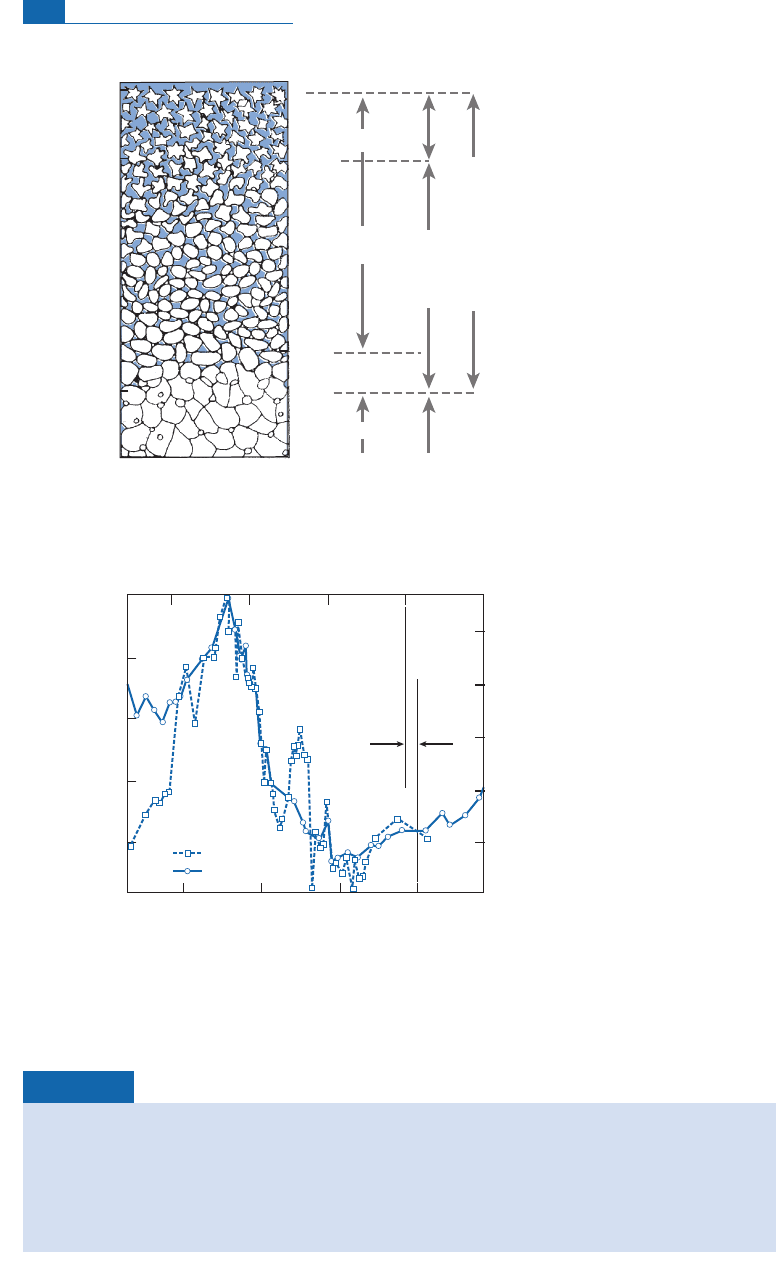
Exercise
Argon and nitrogen isotope fractionations are caused by gravitational fractionation in the ice
over the poles. Using what has been shown for liquid–vapor isotope fractionation, find the
formula explaining this new isotope thermometer.
Answer
If we write the fractionation:
Age (BC) for δ
40
Ar
Age in years (BC) for CO
2
235 000 240 000 245 000 250 000
235 000 240 000 245 000 250 000
200
220
240
260
2.20
2.15
2.10
800 years
2.05
2.00
δ
40
Ar (‰)
CO
2
(ppm)
CO
2
δ
40
Ar
Figure 7.38 Records of
40
Ar and CO
2
from the Vostok core after shifting the CO
2
curve 800 years
backwards. After Caillon
et
a
l
.(2003).
Depth (m)
50-120
0.83
0.80
0.55
Density (g cm
–3
)
Surface
15
0
Free contact
with atmosphere
Isolated air
Diffuse contact
with atmosphere
Compaction
Δt = interval of time
Snow
Ice
Closure of
gas inclusion
Figure 7.37 As ice is compacted, the air trapped is younger than the snow.
418 Stable isotope geochemistry
